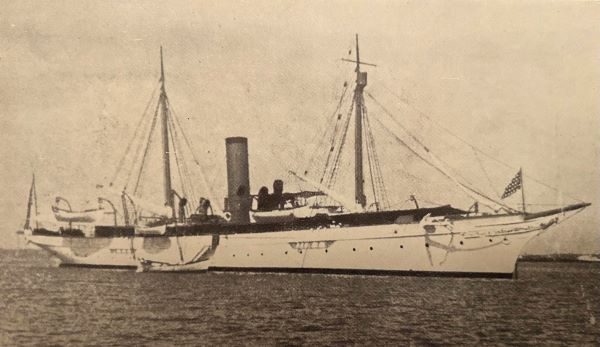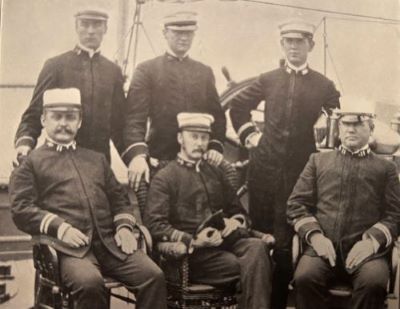

by Patrick McSherry

The converted yacht U.S.S. YANKTON
The vessel was assigned to the blockade of Cuba.
YANKTON departed Hampton Roads on June 18, first being sent to Santiago
and then to Cienfuegos, where it arrived on June 27. On June 29, YANKTON
joined the U.S.S. EAGLE in bombarding Spanish shore batteries near
Casilda, Cuba. Also, while off Cienfuegos,
YANKTON took up the chase of a Spanish merchantman, the ALFONSO XII,
that was attempting to run the blockade. YANKTON was, unfortunately,
unable to catch her, but she was later forced aground near Mariel by the
U.S.S. CASTINE and U.S.S. HAWK. On July 21
the vessel returned to Santiago and was sent immediately to Guantanamo
Bay which she reached with only shovels full of coal left in er bunkers.
The vessel returned to Cienfuegos on August 1. Shortly
afterwards, on August 12 an armistice was reached between the United
States and Spain ending the war's fighting. YANKTON returned to
the U.S., arriving at Key West, Florida on August 17, and arriving in
Norfolk, Virginia on September 17. On September 24, Lt. Cmdr. Adams was
transferred to duties in Washington. Adams was replaced by Lt. G. L.
Dyer. Before the war ended on December 10, 1898 with the signing of the
Treaty of Paris. YANKTON was being
refitted as coastal survey vessel.

Following the war YANKTON returned to Cuba to perform coastal survey,
surveying Santiago Harbor, Nipe Bay, Levisa Bay, Gibara, Cienfuegos, and
the Isle of Pines among others. She also surveyed portions of the coast
of Puerto Rico. This work was completed in 1903 and YANKTON became the
tender to the U.S.S. FRANKLIN through 1904. Next she became tender to
the new U.S.S. MAINE until 1906, when she began serving as a support
vessel throughout the Atlantic Fleet.
From 1907 through 1909 YANKTON was part of the unprecedented world cruise of the American Battle Fleet, better known as the "Great White Fleet" where she acted in support and served the fleet commanders. During the cruise, the YANKTON was ordered on a side mission to the Galapagos Islands to attempt to locate an American shipwreck survivor. Though evidence was found of the man's presence, neither he nor his body could be located. Later, when in the Mediterranean, YANKTON stopped at Messina, Sicily to aid the victims of an earthquake that had hit the island.
From 1909 to 1917 YANKTON again served as tender to the Atlantic
Fleet. During World War One she served as part of the Patrol Force,
initially serving off the northeastern U.S. coast and then off
Gibraltar, patrolling the coasts of England, France, and the western
Mediterranean to defend shipping convoys from the threat of submarine
attack. YANKTON returned to the U.S. in September of 1918. Following the
Armistice, YANKTON was ordered back to Europe and supported the
Murmansk, Russia, expedition. The commander of the American forces in
northern Russia, Rear Admiral N. A. McCully, briefly resided aboard
YANKTON. The vessel conducted patrols, acted as a military transport and
as the radio ship for Murmansk. In 1919 YANKTON was ordered to England
and then back to New York in 1920 where she was decommissioned. She was
sold later the same year becoming a merchant vessel.
In 1922 YANKTON was captured as a rum runner but eventually returned
to commercial service. She was finally broken up and scrapped in 1930.
The YANKTON served as a support vessel, a messenger and a lightly armed patrol vessel. She was able to perform these duties. However, she was unarmored, and only lightly armed and could not take part in any major action. Her speed was acceptable, though not exceedingly fast.
| Classification: | Patrol Yacht | |
| Launched: | April 29, 1893 | |
|---|---|---|
| Commissioned: | May 16, 1898 | |
| Armament: | One 4 inch Gun (not agreed on by all sources) | |
| Six 3-Pounder Guns | ||
| Two Colt Machine Guns | ||
| Contractor: | Ramage & Ferguson of Leith, Scotland | |
| Complement: | 78 men under the command of Lt. Cmdr. John Dexter Adams | |
| Length: | 185 feet | |
| Beam: | 27 feet, 6 inches | |
| Mean draft: | 13 feet, 10 inches | |
| Displacement: | 975 tons | |
| Engine type: | Triple expansion engine, generating 750 hp.; Single screw | |
| Speed: | 14 knots | |
| Coal bunker capacity: | 70 tons | |
| Armor | None |
Clerk of Joint Committee on Printing, The Abridgement of Message
from the President of the United States to the Two Houses of
Congress. (Washington: Government Printing Office, 1899). Vol.
2, 1218-1221, 1250-1251.
Dictionary of American Naval Fighting Ships. Vol. 8 (Washington: Naval History Center, 1981) 514-516.
Report of the Chief of the Bureau of Navigation. (Washington: Government Printing Office, 1898) 43.
Willoughby, Malcolm F., YANKTON, Yacht and
Man-of-War. (Cambridge, Massachusetts: Crimson Printing
Company, 1935).